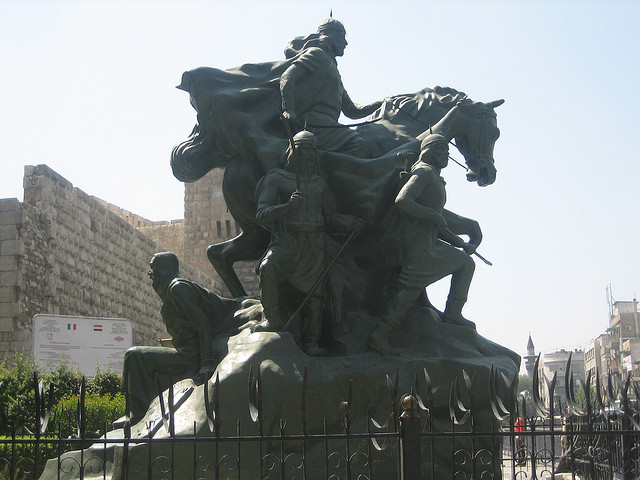
Third Crusade
Hattin and the fall of Jerusalem prompted the Third Crusade (1189-1192), financed in England by a special "Saladin tithe". Richard I of England (Richard the Lionheart) led Guy's siege of Acre, conquered the city and executed 3,000 Muslim prisoners, including women and children. Bahā' ad-Dīn wrote:
The motives of this massacre are differently told; according to some, the captives were slain by way of reprisal for the death of those Christians whom the Musulmans had slain. Others again say that the king of England, on deciding to attempt the conquest of Ascalon, thought it unwise to leave so many prisoners in the town after his departure. God alone knows what the real reason was.
Saladin retaliated by killing all Franks captured from August 28 – September 10. Bahā' ad-Dīn writes, "Whilst we were there they brought two Franks to the Sultan (Saladin) who had been made prisoners by the advance guard. He had them beheaded on the spot."
The armies of Saladin engaged in combat with the army of King Richard at the Battle of Arsuf on September 7, 1191, at which Saladin's forces were defeated. After the battle of Arsuf, Richard moved his forces towards Ascalon. Anticipating Richard's next move, Saladin emptied the city and camped a few miles away. When Richard arrived at the city, he was stunned to see it abandoned and the towers demolished. The next day when Richard was preparing to retreat to Jaffa, Saladin attacked his Army. After a furious battle, Richard managed to save some of his troops and retreated to Ascalon. This was the last major battle between the two forces. All military attempts and battles made by Richard the Lionheart to re-take Jerusalem were defeated and failed. Richard only had 2,000 fit soldiers and 50 fit knights to use in battle. With such a small force, Richard could not hope to take Jerusalem even though he got near enough to see the Holy City. However, Saladin's relationship with Richard was one of chivalrous mutual respect as well as military rivalry.
Death
Saladin died of a fever on March 4, 1193, at Damascus, not long after Richard's departure. In Saladin’s possession at the time of his death were 1 piece of gold and 47 pieces of silver. He had given away his great wealth to his poor subjects and there was none left to pay for his funeral.He was buried in a mausoleumin the garden outside the Umayyad Mosque in Damascus, Syria.
Seven centuries later, Emperor Wilhelm II of Germany donated a new marblesarcophagus to the mausoleum. Saladin was, however, not placed in it. Instead the mausoleum, which is open to visitors, now has two sarcophagi: the empty one made of marble and the original wooden one, which holds Saladin.

